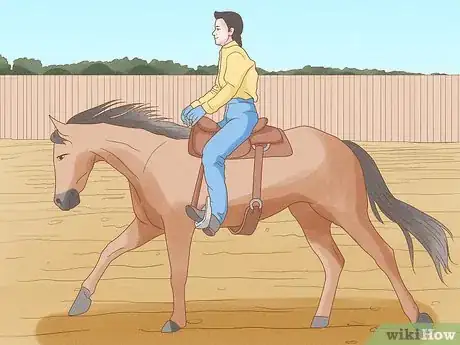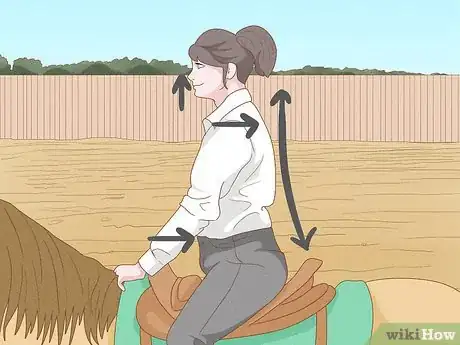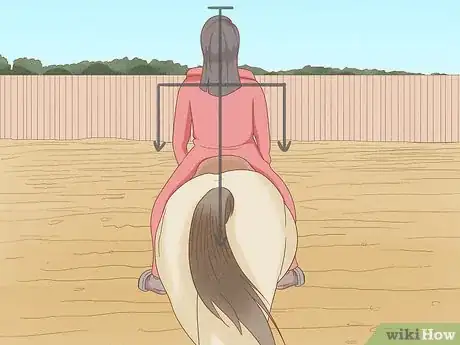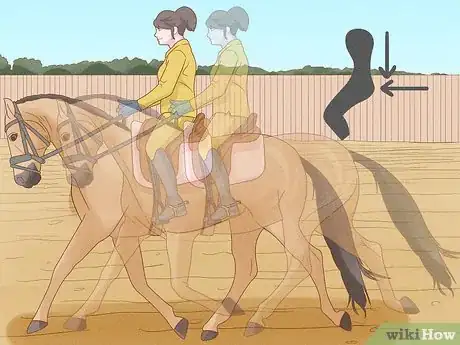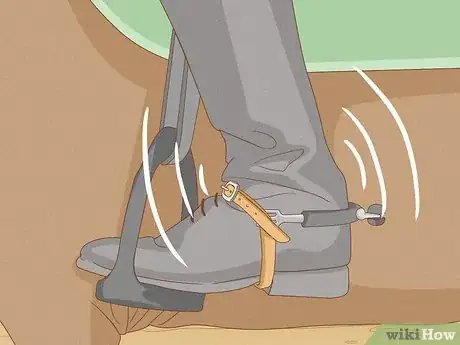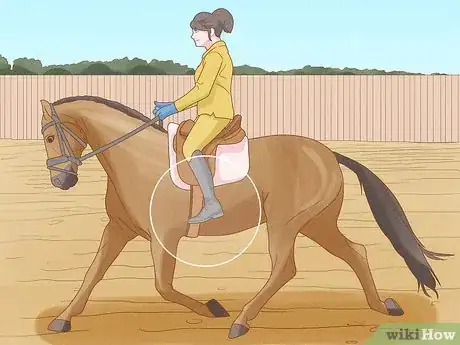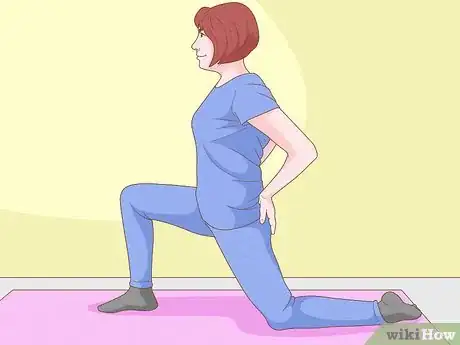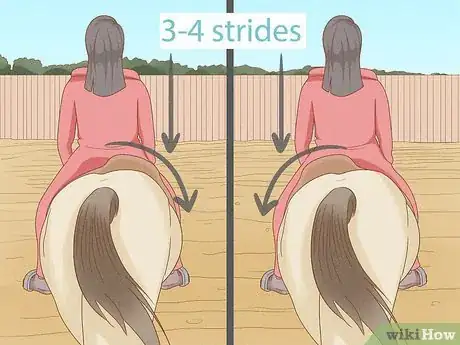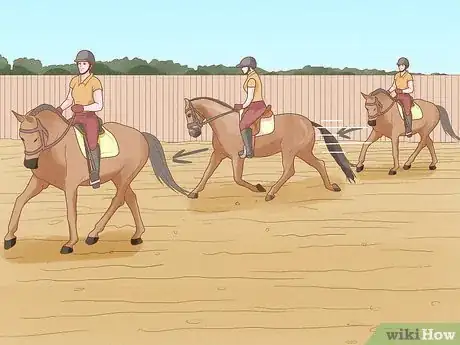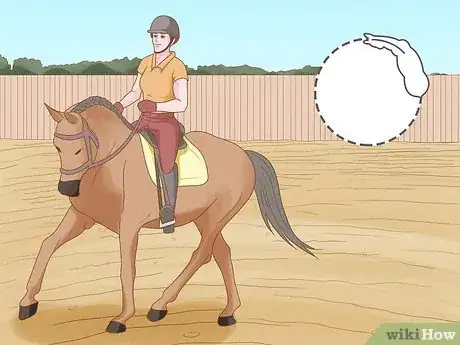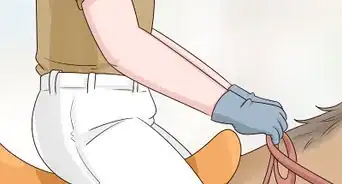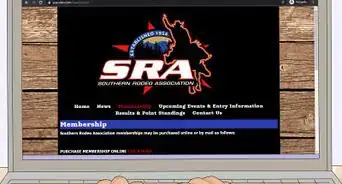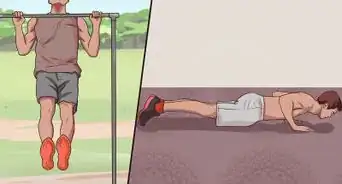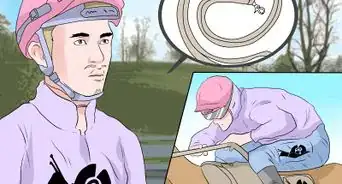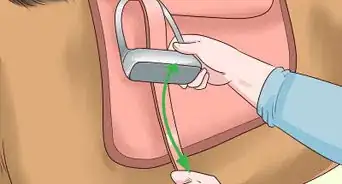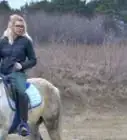This article was co-authored by wikiHow staff writer, Amber Crain. Amber Crain has been a member of wikiHow’s writing staff for the last six years. She graduated from the University of Houston where she majored in Classical Studies and minored in Painting. Before coming to wikiHow, she worked in a variety of industries including marketing, education, and music journalism. She's been a radio DJ for 10+ years and currently DJs a biweekly music program on the award-winning internet radio station DKFM. Her work at wikiHow supports her lifelong passion for learning and her belief that knowledge belongs to anyone who desires to seek it.
There are 13 references cited in this article, which can be found at the bottom of the page.
This article has been viewed 7,973 times.
Learn more...
No matter how much experience you have riding horses, mastering the sitting trot can seem daunting at first. Developing balance, core strength, and proper form are the keys to riding a great sitting trot, so all you need to do is get out there and practice. We'll walk you through everything you need to know to perfect your technique and lead you through some simple training exercises that'll have you sitting the trot in no time!
Steps
Form and Technique
-
1Mount your horse and sit in the saddle comfortably. Get into your horse’s saddle as you normally would, but keep your horse still. It can be tough to readjust your body properly once your horse is moving, so take a moment to relax into the saddle and align your body before sitting the trot.[1]
- Young, untrained horses may not be strong enough to support a sitting trot yet. Practice on an experienced horse.[2]
-
2Engage your core and lift your spine in a neutral, upright position. Lift your chin, roll your shoulders back, and straighten your spine so your back is flat and upright. Tighten your core muscles and adjust your body so you aren’t leaning forward or backward in the saddle. Try to picture a straight line running from your ear down through your shoulder, hip, and ankle on each side of your body.[3]
- It can also help to imagine your horse suddenly disappearing beneath you. Would you land on your feet, or would you fall slightly forward on your face or backwards on your bottom?[4]
- Doing core exercises regularly can help you strengthen this area.
Advertisement -
3Distribute your weight evenly between both sides of your body. Rotate your pelvis and adjust your bottom so your weight is sitting equally over both seat bones and the back of your pubic bone. Make sure your seat bones are pointing straight down at the ground and your lower back is flat.[5]
- Don’t get discouraged if you're having a tough time with balance. Every rider struggles with this, even the pros! Just keep practicing and you’ll nail it.[6]
-
4Relax your legs and rest your feet evenly on the stirrups. Loosen up your hip muscles so your legs lengthen and hang naturally around the horse’s body. Place your feet in the stirrups, keeping them relaxed and level without flexing your ankles. Instead of pushing down with your heels, remind yourself to keep your toes lifted so your feet stay level.[7]
- Lower leg gripping is a common problem for all riders. It helps to continually remind yourself to loosen up your leg and hip muscles as you’re riding.[8]
- Some trainers suggest picturing everything from your waist down lengthening and reaching toward the ground, and everything from the waist up stretching upward toward the sky.[9]
-
5Drop your shoulders down and forward slightly as you grab the reins. Grab the reins with both hands as you normally would. Take a moment to drop your shoulders and elbows down and then slightly forward. It can help to imagine that you’re pushing your hands toward the horse’s mouth.[10]
- This helps you keep your shoulders back and chest open.
- Now that you're in position, sit quietly for a moment and take a few deep breaths to center yourself.[11]
-
6Keep your hips loose and back flat to absorb the shock as you bounce. As your horse moves into a trot, it’s natural to want to hollow or curve your back to absorb the shock. Remember to stabilize your back and keep it flat, though! Your back should not move at all. Loosen your hips and let your hip joints bounce and move naturally with your horse.[12]
- Engage those core muscles to help you firm up your back and keep it flat.
- Avoid letting your head nod or bounce around. This happens when you try to absorb the shock with your head and neck. Let your hips do that.[13]
-
7Relax your body into the movements rather than bracing against them. Allow your body to relax and move up and down with the horse. Don’t try to fight or brace yourself against the movement with your knees, hips, or back. Let yourself bounce in rhythm of your horse’s trot. Bouncing and moving with your horse can feel a bit scary, but as long as you keep your core engaged, back flat, and legs loose, you won’t lose your balance.[14]
- Keep your heels loose and remember not to drive them down. Let your ankles absorb the shock of your bouncing body.[15]
- Check in with yourself regularly to see if you're gripping your horse with your knees. If you are, remind yourself to loosen up your legs.
Training Exercises
-
1Practice without stirrups to improve your form and core strength. If you can't seem to stop tensing your legs and gripping with your knees, try removing your horse’s stirrups. This can help you break the habit of tensing up and bracing yourself against the stirrups for balance. It also forces your thighs and legs to lengthen and drape loosely around your horse’s body.[16]
- Another trick is attaching light ankle weights to your ankles and walking your horse slowly on the lunge line. This gives you a sense of how your legs should hang down during the trot.[17]
-
2Try a hip angle exercise to get used to moving with the horse. If you’re having trouble keeping your hips loose to absorb your horse’s movements, give this a try. Start in sitting trot and lean your upper body back slightly. This forces your hip angle to open up so you can really feel the horse’s movements through your hips. Do this for several strides before slowly straightening back into the proper vertical position. Try to keep your hips open at the right angle once you’re vertical again.[18]
- Repeat this exercise 3-4 times, giving your horse a walking break in between.
-
3Drop alternate seat bones every 3-4 strides to help you stay balanced. Start the trot as you normally would. Drop your right seat bone down on the saddle on the first stride. After your horse takes 3 more strides, drop your left seat bone. Continue alternating seat bones every 3-4 strides, keeping your core engaged and your shoulders level so you don’t lean when you drop.[19]
- Each time you drop a seat bone, you’re forced to relax the muscles on that side of your lower body. This helps you develop muscle independence.
- As you’re riding, notice if you naturally favor or sit heavier on a particular seat bone. If you catch yourself automatically favoring one seat bone over the over, work on “unlearning” that habit so you can maintain your balance. [20]
-
4Go from walking to trotting in short bursts, aiming for quality not quantity. Start your horse in a normal walk and take a moment to center yourself. Then, nudge your horse into several trotting strides. Focus on perfecting your form and moving naturally with your horse. Slow the horse back down to a walk for a few strides and then repeat the pattern a few more times.[21]
-
5Sit the trot in a large circle to practice curves and changes in direction. Ride your horse in a large circle, walking for half of it and transitioning to sitting trot for the other half. As you transition, make sure your horse doesn’t slow down and you’re maintaining proper form each time. During the walking sections, remind yourself to center and relax your body before transitioning into the next sitting trot.[24]
- Do this for a few laps during each training session to improve your sitting trot.
References
- ↑ https://practicalhorsemanmag.com/training/master-sitting-trot-11539
- ↑ https://www.fei.org/stories/lifestyle/teach-me/3-steps-steady-lower-leg-sitting-trot
- ↑ https://horse-canada.com/magazine/training/improve-sitting-trot/
- ↑ https://practicalhorsemanmag.com/training/master-sitting-trot-11539
- ↑ https://horse-canada.com/magazine/training/improve-sitting-trot/
- ↑ https://heelsdownmag.com/sit-the-trot-like-an-olympian/
- ↑ https://horse-canada.com/magazine/training/improve-sitting-trot/
- ↑ https://heelsdownmag.com/sit-the-trot-like-an-olympian/
- ↑ https://thehorseinmotion.com/the-perfect-sitting-trot-2/
- ↑ https://practicalhorsemanmag.com/training/master-sitting-trot-11539
- ↑ https://thehorseinmotion.com/the-perfect-sitting-trot-2/
- ↑ https://www.youtube.com/watch?t=67&v=NR2W96UVsZw&feature=youtu.be
- ↑ https://www.youtube.com/watch?t=249&v=EdHcbd9SU5E&feature=youtu.be
- ↑ https://www.youtube.com/watch?t=123&v=NR2W96UVsZw&feature=youtu.be
- ↑ https://www.youtube.com/watch?t=142&v=EdHcbd9SU5E&feature=youtu.be
- ↑ https://www.fei.org/stories/lifestyle/teach-me/3-steps-steady-lower-leg-sitting-trot
- ↑ https://www.horsejournals.com/master-sitting-trot
- ↑ https://www.horsejournals.com/master-sitting-trot
- ↑ https://thehorseinmotion.com/the-perfect-sitting-trot-2/
- ↑ https://www.youtube.com/watch?t=34&v=29tzSVH5ccw&feature=youtu.be
- ↑ https://www.youtube.com/watch?t=246&v=NR2W96UVsZw&feature=youtu.be
- ↑ https://www.youtube.com/watch?t=399&v=EdHcbd9SU5E&feature=youtu.be
- ↑ https://heelsdownmag.com/sit-the-trot-like-an-olympian/
- ↑ https://thehorseinmotion.com/the-perfect-sitting-trot-2/
